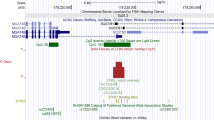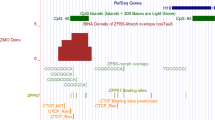Abstract
We have mapped the matrix-attachment regions (MARs) in 200 kilobases of the mouse Chromosome (Chr) 7F imprinted domain. MARs are genetic elements known to have effects in ris on methylation at nonimprinted loci. The imprinting of the Igf2 and Ins2 genes is dependent on the transcription of the downstream H19 gene. The transcription of H19 is dependent in turn on its methylation status. The cis-acting regulators of methylation at this site are not known. As MARs are potential regulators not only of methylation but also other elements of genomic imprinting, we mapped the MARs within the 200 kilobases around H19. This report describes the mapping of four MARs from this region.
Similar content being viewed by others
References
Amati BB, Gasser SM (1988) Chromosomal ARS and CEN elements bind specifically to the yeast nuclear scaffold. Cell 54, 967–978
Bartolomei MS, Zemel S, Tilghman SM (1991) Parental imprinting of the mouse H19 gene. Nature 351, 153–155
Bartolomei MS, Webber AL, Brunkow ME, Tilghman SM (1993) Epigenetic mechanisms underlying the imprinting of the mouse H19 gene. Genes Dev 7, 1663–1673
Boulikas T (1993) Nature of DNA sequences at the attachment regions of genes to the nuclear matrix. J Cell Biochem 52, 14–22
Boulikas T (1995) Chromatin domains and prediction of MAR sequences. Int Rev Cytol 162A, 279–388
Cobianchi F, Wilson SH (1987) Enzymes for modifying and labeling DNA and RNA. Methods Enzymol 152, 94–110
Cockerill PN, Garrard WT (1986) Chromosomal loop anchorage of the kappa immunoglobulin gene occurs next to the enhancer in a region containing topoisomerase II sites. Cell 44, 273–282
Das AT, Luderus ME, Lamers WH (1993) Identification and analysis of a matrix-attachment region 5′ of the rat glutamate-dehydrogenase-encoding gene. Eur J Biochem 215, 777–785
DeChiara TM, Robertson EJ, Efstratiadis A (1991) Parental imprinting of the mouse insulin-like growth factor II gene. Cell 64, 849–859
Dickinson LA, Joh T, Kohwi Y, Kohwi-Shigematsu T (1992) A tissuespecific MAR/SAR DNA-binding protein with unusual binding site recognition. Cell 70, 631–645
Dijkwel PA, Hamlin JL (1988) Matrix attachment regions are positioned near replication initiation sites, genes, and an interamplicon junction in the amplified dihydrofolate reductase domain of Chinese hamster ovary cells. Mol Cell Biol 8, 5398–5409
Dijkwel PA, Hamlin JL (1995) Origins of replication and the nuclear matrix: the DHFR domain as a paradigm. Int Rev Cytol 162A, 455–484
Dobbs DL, Shaiu WL, Benbow RM (1994) Modular sequence elements associated with origin regions in eukaryotic chromosomal DNA. Nucleic Acids Res 22, 2479–2489
Elson DA, Bartolomei MS (1997) A 5’ differentially methylated sequence and the 3′-flanking region are necessary for H19 transgene imprinting. Mol Cell Biol 17, 309–317
Feil R, Walter J, Allen ND, Reik W (1994) Developmental control of allelic methylation in the imprinted mouse Igf2 and H19 genes. Development 120, 2933–2943
Forrester WC, van Genderen C, Jenuwein T, Grosschedl R (1994) Dependence of enhancer-mediated transcription of the immunoglobulin mu gene on nuclear matrix attachment regions. Science 265, 1221–1225
Gasser SM, Laemmli UK (1986) Cohabitation of scaffold binding regions with upstream/enhancer elements of three developmentally regulated genes of D. melanogaster. Cell 46, 521–530
Gasser SM, Amati BB, Cardenas ME, Hofmann JF (1989) Studies on scaffold attachment sites and their relation to genome function. Int Rev Cytol 119, 57–96
Hanson RD, Ley TJ (1992) A-T-rich scaffold attachment regions flank the hematopoietic serine protease genes clustered on chromosome 14ql 1.2. Blood 79, 610–618
Jarman AP, Higgs DR (1988) Nuclear scaffold attachment sites in the human globin gene complexes. EMBO J 7, 3337–3344
Jenuwein T, Forrester WC, Fernandez-Herrero LA, Laible G, Dull M, Grosschedl R (1997) Extension of chromatin accessibility by nuclear matrix attachment regions. Nature 385, 269–272
Kas E, Chasin LA (1987) Anchorage of the Chinese hamster dihydrofolate reductase gene to the nuclear scaffold occurs in an intragenic region. J Mol Biol 198, 677–692
Kas E, Laemmli UK (1992) In vivo topoisomerase II cleavage of the Drosophila histone and satellite III repeats: DNA sequence and structural characteristics. EMBO J 11, 705–716
Khosla S, Kantheti P, Brahmachari V, Chandra HS (1996) A male-specific nuclease-resistant chromatin fraction in the mealybug Planococcus lilacinus. Chromosoma 104, 386–392
Kirillov A, Kistler B, Mostoslavsky R, Cedar H, Wirth T, Bergman Y (1996) A role for nuclear NF-κB in B-cell-specific demethylation of the IgK locus. Nature Genet 13, 435–441
Koide T, Ainscough J, Wijgerde M, Surani MA (1994) Comparative analysis of Igf-2/H19 imprinted domain: identification of a highly conserved intergenic DNase I hypersensitive region. Genomics 24, 1–8
Kramer JA, Singh GB, Krawetz SA (1996) Computer-assisted search for sites of nuclear matrix attachment. Genomics 33, 305–308
Leighton PA, Ingram RS, Eggenschwiler J, Efstratiadis A, Tilghman SM (1995) Disruption of imprinting caused by deletion of the H19 gene region in mice. Nature 375, 34–39
Lichtenstein M, Keini G, Cedar H, Bergman Y (1994) B cell-specific demethylation: a novel role for the intronic kappa chain enhancer sequence. Cell 76, 913–923
Moss SB, Burnham BL, Bellve AR (1993) The differential expression of lamin epitopes during mouse spermatogenesis. Mol Reprod Dev 34, 164–174
Nicholls RD (1994) New insights reveal complex mechanisms involved in genomic imprinting. Am J Hum Genet 54, 733–740
Paldi A, Gyapay G, Jami J (1995) Imprinted chromosomal regions of the human genome display sex-specific meiotic recombination frequencies. Curr Biol 5, 1030–1035
Passananti C, Corbi N, Paggi MG, Russo MA, Perez M, Cotelli F, Stefanini M, Amati P (1995) The product of Zfp59 (Mfg2), a mouse gene expressed at the spermatid stage of spermatogenesis, accumulates in spermatozoa nuclei. Cell Growth Differ 6, 1037–1044
Pfeifer K, Leighton PA, Tilghman SM (1996) The structural H19 gene is required for transgene imprinting. Proc Natl Acad Sci USA 93, 13876–13883
Phi-Van L, Stratling WH (1988) The matrix attachment regions of the chicken lysozyme gene co-map with the boundaries of the chromatin domain. EMBO J 7, 655–664
Razin A, Cedar H (1994) DNA methylation and genomic imprinting. Cell 77, 473–476
Reik W, Brown KW, Schneid H, Lebouc Y, Bickmore W, Maher EW (1995) Imprinting mutations in the Beckwith-Wiedemann syndrome suggested by an altered imprinting pattern in the IGF2-H19 domain. Hum Mol Genet 4, 2379–2385
Robinson WP, Lalande M (1995) Sex-specific meiotic recombination in the Prader-Willi/Angelman syndrome imprinted region. Hum Mol Genet 4, 801–806
Romig H, Ruff J, Fackelmayer FO, Patil MS, Richter A (1994) Characterisation of two intronic nuclear-matrix-attachment regions in the human DNA topoisomerase I gene. Eur J Biochem 221, 411–419
Rotwein P, Hall LJ (1990) Evolution of insulin-like growth factor II: characterization of the mouse IGF-II gene and identification of two pseudo-exons. DNA Cell Biol 9, 725–735
Saitoh S, Buiting K, Rogan PK, Buxton JL, Driscoll DJ, Arnemann J, Konig R, Malcolm S, Horsthemke B, Nicholls RD (1996) Minimal definition of the imprinting center and fixation of a chromosome 15ql 1-13 epigenotype by imprinting mutations. Proc Natl Acad Sci USA 93, 7811–7815
Stewart C, Burke B (1987) Teratocarcinoma stem cells and early mouse embryos contain only a single major lamin polypeptide closely resembling lamin B. Cell 51, 383–392
Surani MA (1993) Genomic imprinting. Silence of the genes. Nature 366, 302–303
Tsang P, Gilles F, Yuan L, Kuo Y-H, Lupu F, Samara G, Moosikasuwan J, Goye A, Zelenetz AD, Selleri L, Tycko B (1995) A novel L23-related gene 40 kb downstream of the imprinted H19 gene is biallelically expressed in mid-fetal and adult human tissues. Hum Mol Genet 4, 1499–1507
Vaughn JP, Dijkwel PA, Mullenders LH, Hamlin JL (1990) Replication forks are associated with the nuclear matrix. Nucleic Acids Res 18, 1965–1969
Vogelstein B, Pardoll DM, Coffey DS (1980) Supercoiled loops and eucaryotic DNA replication. Cell 22, 79–85
Ward WS, Coffey DS (1990) Specific organization of genes in relation to the sperm nuclear matrix. Biochem Biophys Res Commun 173, 20–25
Yuan L, Qian N, Tycko B (1996) An extended region of biallelic gene expression and rodent-human synteny downstream of the imprinted H19 gene on chromosome 11pl5.5. Hum Mol Genet 5, 1931–1937
Zemel S, Bartolomei MS, Tilghman SM (1992) Physical linkage of two mammalian imprinted genes, H19 and insulin-like growth factor 2. Nature Genet 2, 61–65
Author information
Authors and Affiliations
Additional information
The nucleotide sequence data reported in this paper have been submitted to GenBank and are assigned the accession numbers U71190-3 and U71209.
Rights and permissions
About this article
Cite this article
Greally, J.M., Guinness, M.E., McGrath, J. et al. Matrix-attachment regions in the mouse Chromosome 7F imprinted domain. Mammalian Genome 8, 805–810 (1997). https://doi.org/10.1007/s003359900583
Received:
Accepted:
Issue Date:
DOI: https://doi.org/10.1007/s003359900583




